Experimental Study on Gas–Liquid Two-Phase Flow Upstream and Downstream of U-Bends
Abstract
:1. Introduction
2. Experimental Setup
2.1. Experimental Equipment
2.2. Test Section for Pressure Drop Measurements and Visualization
2.3. Experimental Conditions
3. Results and Discussion
3.1. Frictional Pressure Gradient in Straight Pipe Sections of U-Tubes
3.1.1. Frictional Pressure Gradient in the Distant Straight Tube Section
3.1.2. Comparison of Pressure Gradients in Straight Pipe Sections Close and Distant to the U-Bends
3.2. Link between Flow Pattern and Disturbance Degree
3.3. Axial Propagation Characteristics of Pressure Pulsation
4. Conclusions
- (1)
- The disturbance from the U-bend in the two-phase flow in the vicinity of the bend was very obvious. The ratios of pressure gradients in straight pipe sections close and distal to the U-bends ranged from approximately 1.5 to 6 under the experimental conditions.
- (2)
- The disturbance degree of U-bends in the flow in their adjacent straight tubes was highly related to the incoming two-phase flow pattern. The slug flow had the most significant influence, while the effect of plug and annular flows was smaller in comparison. Fundamentally, it depends on the weighting relationship among the gravity, centrifugal force, and inertial force of the gas–liquid two-phase fluid in the elbow.
- (3)
- The pressure fluctuation propagates in the form of a wave in the upstream and downstream straight tubes of the U-bend, and the dominant frequency of the pulsation remains stable during the propagation process. With an increase in the axial distance along the flow direction, the pressure pulsation energy for the straight tube upstream of the U-bend increases gradually, while that of the downstream section attenuates. Additionally, the pressure fluctuation energy downstream of the U-bend was larger than that upstream of the return bend.
Author Contributions
Funding
Data Availability Statement
Conflicts of Interest
References
- Jo, Y.; Song, Y.J.; Jo, D. Gas Accumulation Induced by Temperature Rise and Sudden Pressure Drop in an Inverse U-Bend. Ann. Nucl. Energy 2022, 169, 108928. [Google Scholar] [CrossRef]
- Liu, W.; Jiang, S.; Li, H. Experimental Study of Liquid-Carrying by Swirling Flow in a U-Shaped Tube. Exp. Therm. Fluid Sci. 2022, 130, 110479. [Google Scholar] [CrossRef]
- Pietrzak, M. Flow Patterns and Gas Fractions of Air-Oil and Air-Water Flow in Pipe Bends. Chem. Eng. Res. Des. 2014, 92, 1647–1658. [Google Scholar] [CrossRef]
- Pietrzak, M. Flow Patterns and Volume Fractions of Phases during Liquid-Liquid Two-phase Flow in Pipe Bends. Exp. Therm. Fluid Sci. 2014, 4, 247–258. [Google Scholar] [CrossRef]
- Pietrzak, M.; Witczak, S. Flow Patterns and Void Fractions of Phases during Gas-Liquid Two-phase and Gas-Liquid-Liquid Three-Phase Flow in U-Bends. Int. J. Heat Fluid Flow 2013, 44, 700–710. [Google Scholar] [CrossRef]
- Sharma, M.; Ravi, P.; Ghosh, S.; Das, G.; Das, P.K. Hydrodynamics of Lube Oil-Water Flow through 180° Return Bends. Chem. Eng. Sci. 2011, 66, 4468–4476. [Google Scholar] [CrossRef]
- Graham, P.B.; Mike, J.B.; Jerome, A.N. Upscaling multiphase viscous-to-capillary transitions in heterogeneous porous media. J. Fluid Mech. 2021, 911, A59. [Google Scholar]
- Wang, L.Y.; Golfier, F.; Tinet, A.-J.; Chen, W.Z.; Vuik, C. An efficient adaptive implicit scheme with equivalent continuum approach for two-phase flow in fractured vuggy porous media. Adv. Water Resour. 2022, 163, 104186. [Google Scholar] [CrossRef]
- de Oliveira, P.M.; Barbosa, J.R. Pressure Drop and Gas Holdup in Air-Water Flow in 180° Return Bends. Int. J. Multiph. Flow 2014, 61, 83–93. [Google Scholar] [CrossRef]
- Abdulkadir, M.; Azzi, A.; Zhao, D.; Lowndes, I.S.; Azzopardi, B.J. Liquid Film Thickness Behaviour within a Large Diameter Vertical 180° Return Bend. Chem. Eng. Sci. 2014, 107, 137–148. [Google Scholar] [CrossRef]
- Abdulkadir, M.; Samson, J.N.; Zhao, D.; Okhiria, D.U.; Hernandez-Perez, V. Annular Liquid Film Thickness Prediction in a Vertical 180° Return Bend. Exp. Therm. Fluid Sci. 2018, 96, 205–215. [Google Scholar] [CrossRef]
- López, J.; Ratkovich, N.; Pereyra, E. Analysis of Two-phase Air-Water Annular Flow in U-Bends. Heliyon 2020, 6, e05818. [Google Scholar] [CrossRef] [PubMed]
- Li, Z.; Li, J.; Yan, G.; Galindo-Torres, S.; Scheuermann, A.; Li, L. Mesoscopic model framework for liquid slip in a confined parallel-plate flow channel. Phys. Rev. Fluids 2021, 6, 034203. [Google Scholar] [CrossRef]
- Traviss, D.P.; Rohsenow, W.M. The Influence of Return Bends on the Downstream Pressure Drop and Condensation Heat Transfer in Tubes; Tech. Rep.; Heat Transfer Laboratory, Department of Mechanical Engineering, MIT: Cambridge, MA, USA, 1971. [Google Scholar]
- Wang, C.C.; Chen, I.Y.; Huang, P.S. Two-phase Slug Flow across Small Diameter Tubes with the Presence of Vertical Return Bend. Int. I. Heat Mass Transf. 2005, 48, 2342–2346. [Google Scholar] [CrossRef]
- Wang, C.C.; Chen, I.Y.; Lin, Y.T.; Chang, Y.J. A Visual Observation of the Air-Water Two-phase Flow in Small Diameter Tubes Subject to the Influence of Vertical Return Bends. Chem. Eng. Res. Des. 2008, 86, 1223–1235. [Google Scholar] [CrossRef]
- Wang, C.C.; Chen, I.Y.; Yang, Y.W.; Chang, Y.J. Two-phase Flow Pattern in Small Diameter Tubes with the Presence of Horizontal Return Bend. Int. J. Heat Mass Transf. 2003, 46, 2975–2981. [Google Scholar] [CrossRef]
- Wang, C.C.; Youn Chen, I.; Yang, Y.W.; Hu, R. Influence of Horizontal Return Bend on the Two-Phase Flow Pattern in Small Diameter Tubes. Exp. Therm. Fluid Sci. 2004, 28, 145–152. [Google Scholar] [CrossRef]
- Dang, Z.; Yang, Z.; Yang, X.; Ishii, M. Experimental Study of Vertica and Horizontal Two-phase Pipe Flow through Double 90 Degree Elbows. Int. Heat Mass Transf. 2018, 120, 861–869. [Google Scholar] [CrossRef]
- Qiao, S.; Kim, S. Air-water Two-phase Bubbly Flow across 90° Vertical Elbows. Part I: Experiment. Int. J. Heat Mass Transf. 2018, 123, 1221–1237. [Google Scholar] [CrossRef]
- Qiao, S.; Kong, R.; Kim, S. Air-water Two-phase Bubbly Flow across 90° Vertical Elbows Part II. Model. Int. J. Heat Mass Transf. 2018, 123, 1238–1252. [Google Scholar] [CrossRef]
- Jatau, T.; Bello-Ochende, T. Heat Transfer and Flow Pattern Map Development of R134A in a U-Bend Tube for Flow Boiling Evaporation. Int. Commun. Heat Mass Transf. 2021, 128, 105629. [Google Scholar] [CrossRef]
- Hoang, K.; Davis, M.R. Flow Structure and Pressure Loss for Two Phase Flow in Return Bends. J. Fluid Eng. 1984, 106, 30–37. [Google Scholar] [CrossRef]
- Da Silva Lima, R.J.; Thome, J. Two-Phase Pressure Drops in Adiabatic Horizontal Circular Smooth U-Bends and Contiguous Straight Pipes (RP-1444). Hvac&R Res. 2010, 16, 383–397. [Google Scholar]
- Da Silva Lima, R.J.; Thome, J.R. Two-phase Flow Patterns in U-Bends and Their Contiguous Straight Tubes for Different Orientations Tube and Bend Diameters. Int. J. Refrig. 2012, 35, 1439–1454. [Google Scholar] [CrossRef]
- Padilla, M.; Revellin, R.; Bonjour, J. Two-phase Flow Visualization and Pressure Drop Measurements of HFO-1234yf and R-134a Refrigerants in Horizontal Return Bends. Exp. Therm. Fluid Sci. 2012, 39, 98–111. [Google Scholar] [CrossRef]
- Padilla, M.; Revellin, R.; Wallet, J.; Bonjour, J. Flow Regime Visualization and Pressure Drops of HFO-1234yf, R-134a and R-410A during Downward Two-phase Flow in Vertical Return Bends. Int. J. Heat Fluid Flow 2013, 40, 116–134. [Google Scholar] [CrossRef]
- de Oliveira, P.M.; Strle, E.; Barbosa, J.R. Developing Air-Water Flow Downstream of a Vertical 180° Return Bend. Int. J. Multiph. Flow 2014, 67, 32–41. [Google Scholar] [CrossRef]
- De Kerpel, K.; De Schampheleire, S.; De Keulenaer, T.; De Paepe, M. Two-phase Frictional Pressure Drop and Flow Behaviour up- and Downstream of a Sharp Return Bend. Appl. Therm. Eng. 2016, 93, 824–838. [Google Scholar] [CrossRef]
- Aliyu, A.M.; Almabrok, A.A.; Baba, Y.D.; Lao, L.; Yeung, H.; Kim, K.C. Upward Gas-Liquid Two-phase Flow after a U-Bend in a Large Diameter Serpentine Pipe. Int. J. Heat Mass Transf. 2017, 108, 784–800. [Google Scholar] [CrossRef]
- Ma, X.; Liu, T.; Dai, N.; Tian, M.; Li, S. Experimental investigation on the perturbation length for Air-Water flow upstream and downstream of U-Bends. Front. Energy Res. 2022, 10, 906809. [Google Scholar] [CrossRef]
- Cepeda-Vega, A.; Amaya-Gómez, R.; Asuaje, M.; Torres, C.; Valencia, C.; Ratkovich, N. Pipeline Two-Phase Flow Pressure Drop Algorithm for Multiple Inclinations. Processes 2022, 10, 1009. [Google Scholar] [CrossRef]
- Zhang, H.; Shi, L.; Wang, X.; Sun, R.; Ding, Y.; Tian, H.; Shu, G. Experimental study on the pressure drop characteristics of a supercritical CO2/R134a mixture in a rectangular microchannel. Phys. Fluids 2023, 35, 082013. [Google Scholar] [CrossRef]
- Zhang, R.; Tao, F.; Jin, H.; Guo, X.; He, G.; Ma, L.; Zhang, R.Y.; Gu, Q.; Yang, S. Effect of Liquid Properties on Frictional Pressure Drop in a Gas-Liquid Two-Phase Microchannel. Processes 2022, 10, 799. [Google Scholar] [CrossRef]
- Domanski, P.A.; Hermes, C.J.L. An Improved Correlation for Two-phase Pressure Drop of R-22 and R-410A in 180° Return Bends. Appl. Therm. Eng. 2008, 28, 793–800. [Google Scholar] [CrossRef]
- Padilla, M.; Revellin, R.; Bonjour, J. Prediction and Simulation of Two-phase Pressure Drop in Return Bends. Int. J. Refrig. 2009, 32, 1776–1783. [Google Scholar] [CrossRef]
- Sharma, M.; Ravi, P.; Ghosh, S.; Das, G.; Das, P.K. Studies on Low Viscous Oil-Water Flow through Return Bends. Exp. Therm. Fluid Sci. 2011, 35, 455–469. [Google Scholar] [CrossRef]
- Dassler, C.; Janoske, U. Experimental Investigation of Single- and Two-phase Pressure Drop in Slender Rectangular 180° Return Bends. Exp. Therm. Fluid Sci. 2019, 103, 126–132. [Google Scholar] [CrossRef]
- Zhu, H.; Hu, J.; Gao, Y. Severe slug flow-induced nonlinear dynamic behavior of a flexible catenary riser. Phys. Fluids 2021, 33, 071705. [Google Scholar] [CrossRef]
- Li, C.; Fang, X.; Dai, Q. An experimental investigation of flow boiling instability of R245fa in a horizontal tube. Phys. Fluids 2023, 35, 084122. [Google Scholar] [CrossRef]
- Ma, X.; Tian, M.; Zhang, J.; Tang, L.; Liu, F. Flow pattern identification for two-phase flow in a U-bend and its contiguous straight tubes. Exp. Therm. Fluid Sci. 2018, 93, 218–234. [Google Scholar] [CrossRef]
- De Kerpel, K.; Ameel, B.; Huisseune, H.; Tjoen, C.; Canire, H.; De Paepe, M. Two-phase Flow Behaviour and Pressure Drop of R134a in a Smooth Hairpin. Int. Heat Mass Transf. 2012, 55, 1179–1188. [Google Scholar] [CrossRef]
- Taylor, J.R. An Introduction to Error Analysis: The Study of Uncertainties in Physical Measurements; University Science Books: Sausalito, CA, USA, 1997. [Google Scholar]
- McAdams, W.H.; Wood, W.K.; Bryan, R.L. Vaporization inside horizontal tubes-II-benzene-oil mixtures. Trans. ASME 1942, 66, 671–684. [Google Scholar] [CrossRef]
- Awad, M.M.; Muzychka, Y.S. Effective property models for homogeneous two-phase flows. Exp. Therm. Fluid Sci. 2008, 33, 106–113. [Google Scholar] [CrossRef]
- Chisholm, D. Pressure gradients due to friction during the flow of evaporating two-phase mixtures in smooth tubes and channels. Int. J. Heat Mass Transf. 1973, 16, 347–358. [Google Scholar] [CrossRef]
- Friedel, L. Improved Friction Pressure Drop Correlation for Horizontal and Vertical Two-Phase Pipe Flow. In Proceedings of the European Two-Phase Flow Group Meeting, Ispra, Italy, 5–8 June 1979; pp. 485–492. [Google Scholar]
- Müller-Steinhagen, H.; Heck, K. A simple friction pressure drop correlation for two-phase flow in pipes. Chem. Eng. Prog. 1986, 20, 297–308. [Google Scholar] [CrossRef]
- Xu, Y.; Fang, X. A new correlation of two-phase frictional pressure drop for evaporating flow in pipes. Int. J. Refrig. 2012, 35, 2039–2050. [Google Scholar] [CrossRef]
- Zhang, W.; Hibiki, T.; Mishima, K. Correlations of two-phase frictional pressure drop and void fraction in mini-channel. Int. J. Heat Mass Transf. 2010, 53, 453–465. [Google Scholar] [CrossRef]
- Yan, G.; Li, Z.; Bore, T.; Torres, S.A.G.; Scheuermann, A.; Li, L. A lattice Boltzmann exploration of two-phase displacement in 2D porous media under various pressure boundary conditions. J. Rock Mech. Geotech. 2022, 14, 1782–1798. [Google Scholar] [CrossRef]
- Qiu, B.; Yang, Q.; Yan, J.; Li, G.; Revankar, S. Experimental investigation on the propagation characteristics of pressure oscillation in direct contact condensation with low mass flux steam jet. Exp. Therm. Fluid Sci. 2017, 88, 400–408. [Google Scholar] [CrossRef]
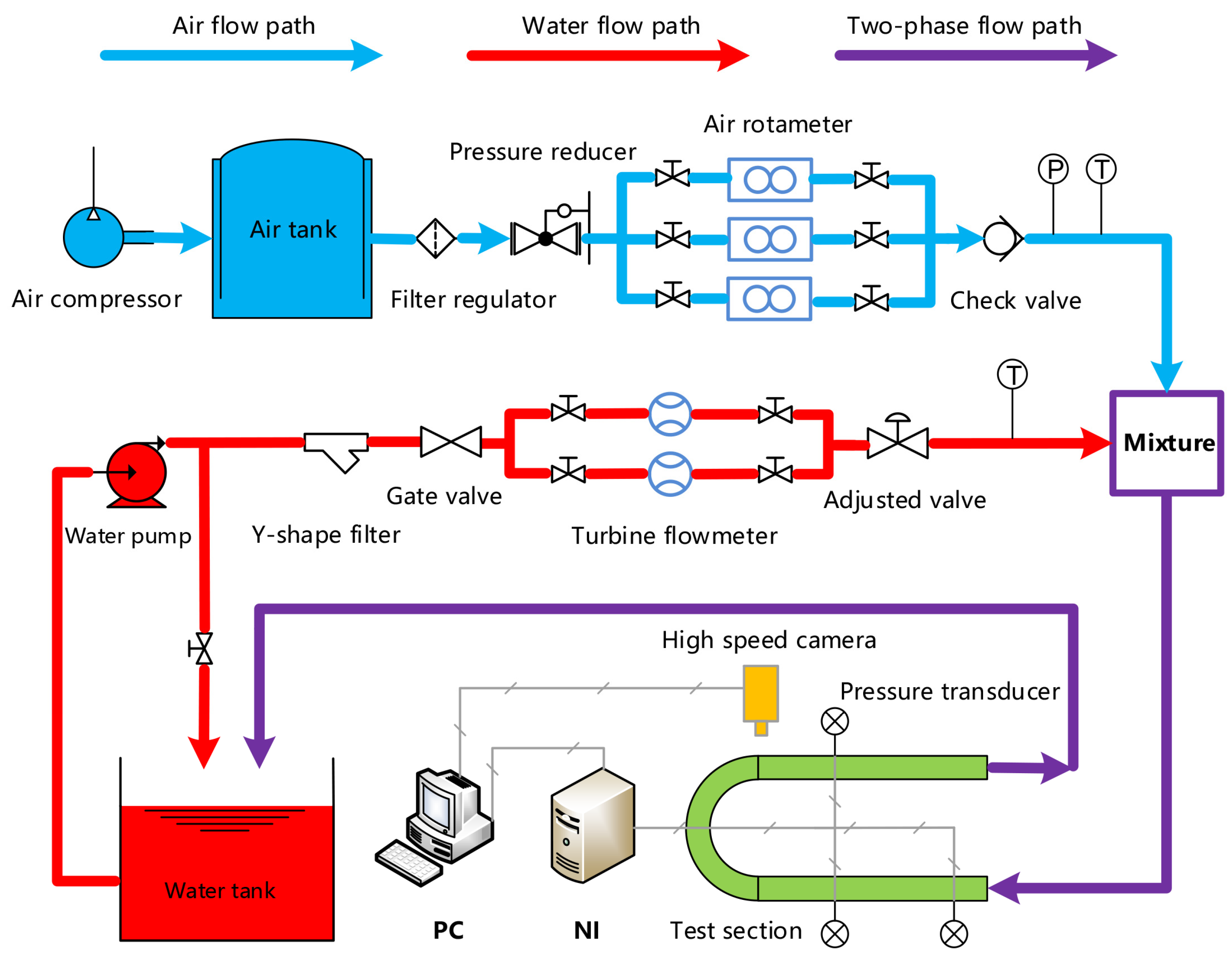

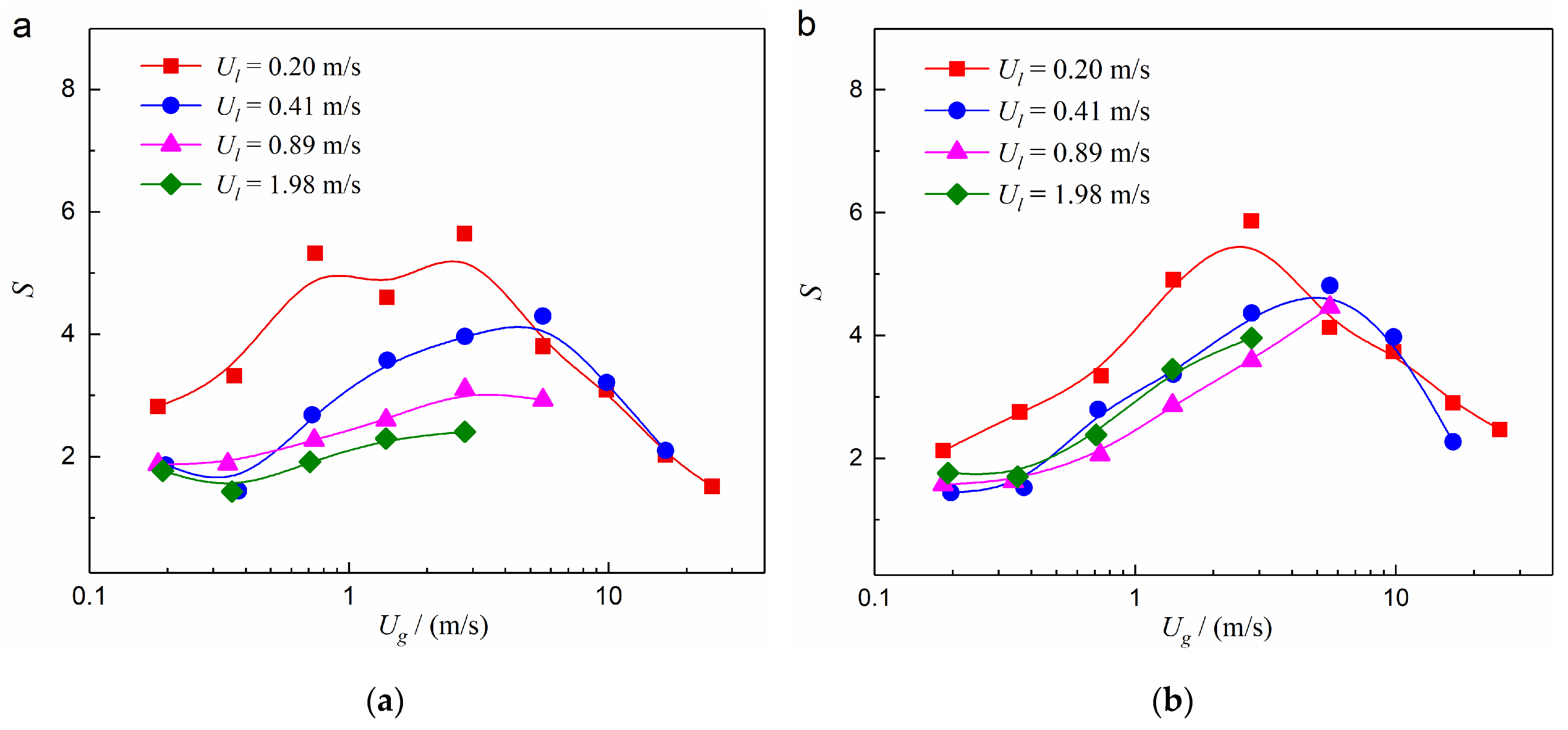


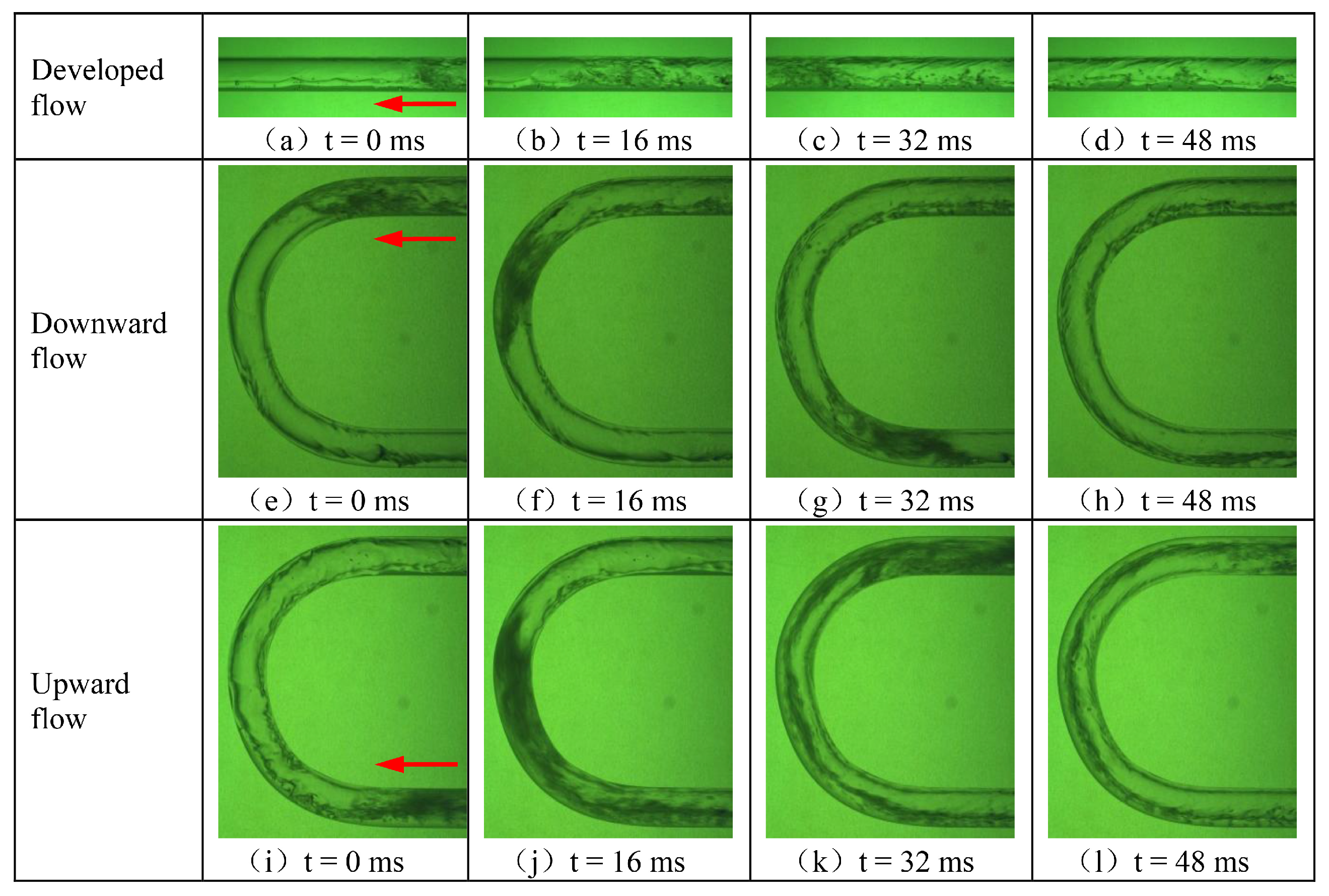
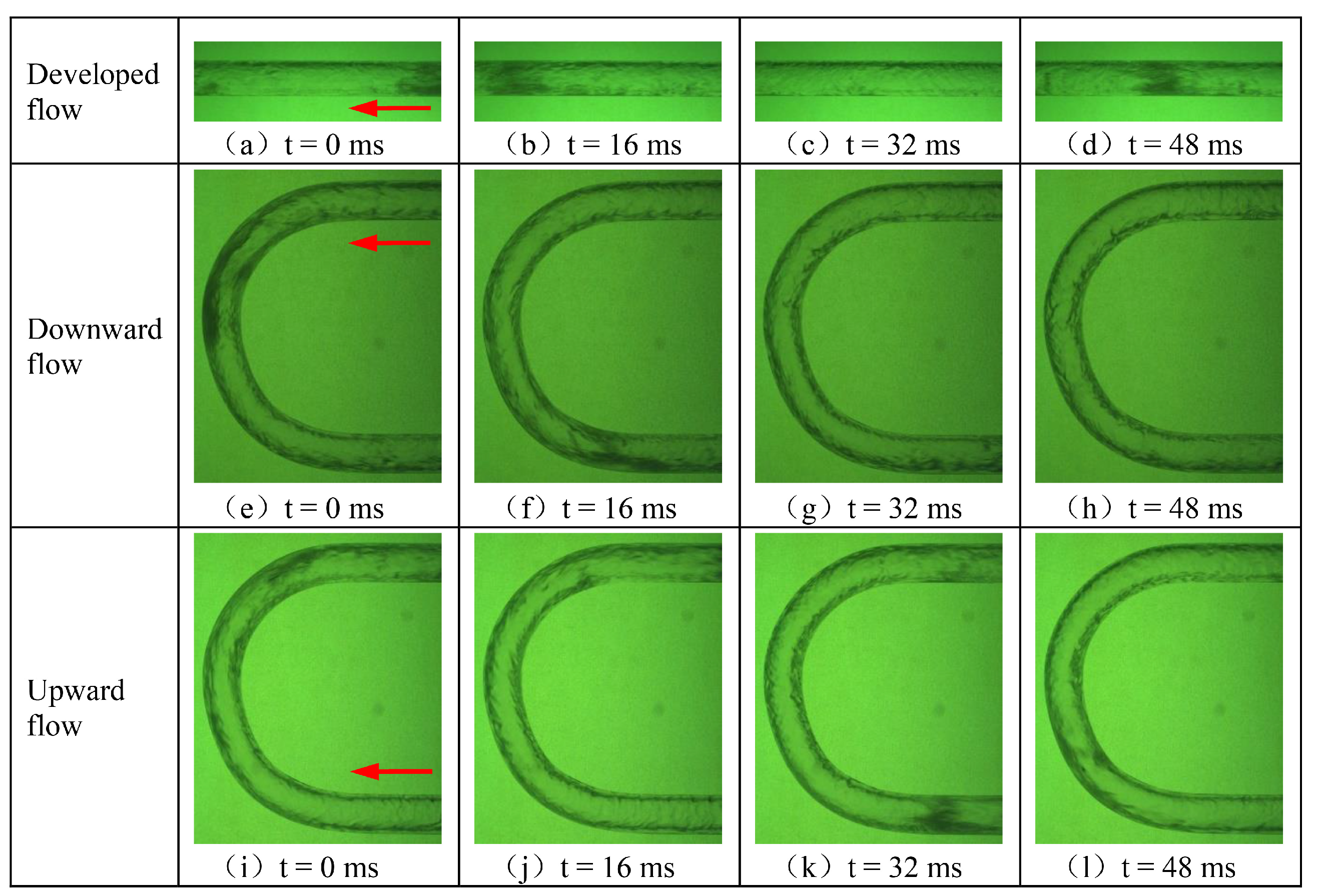
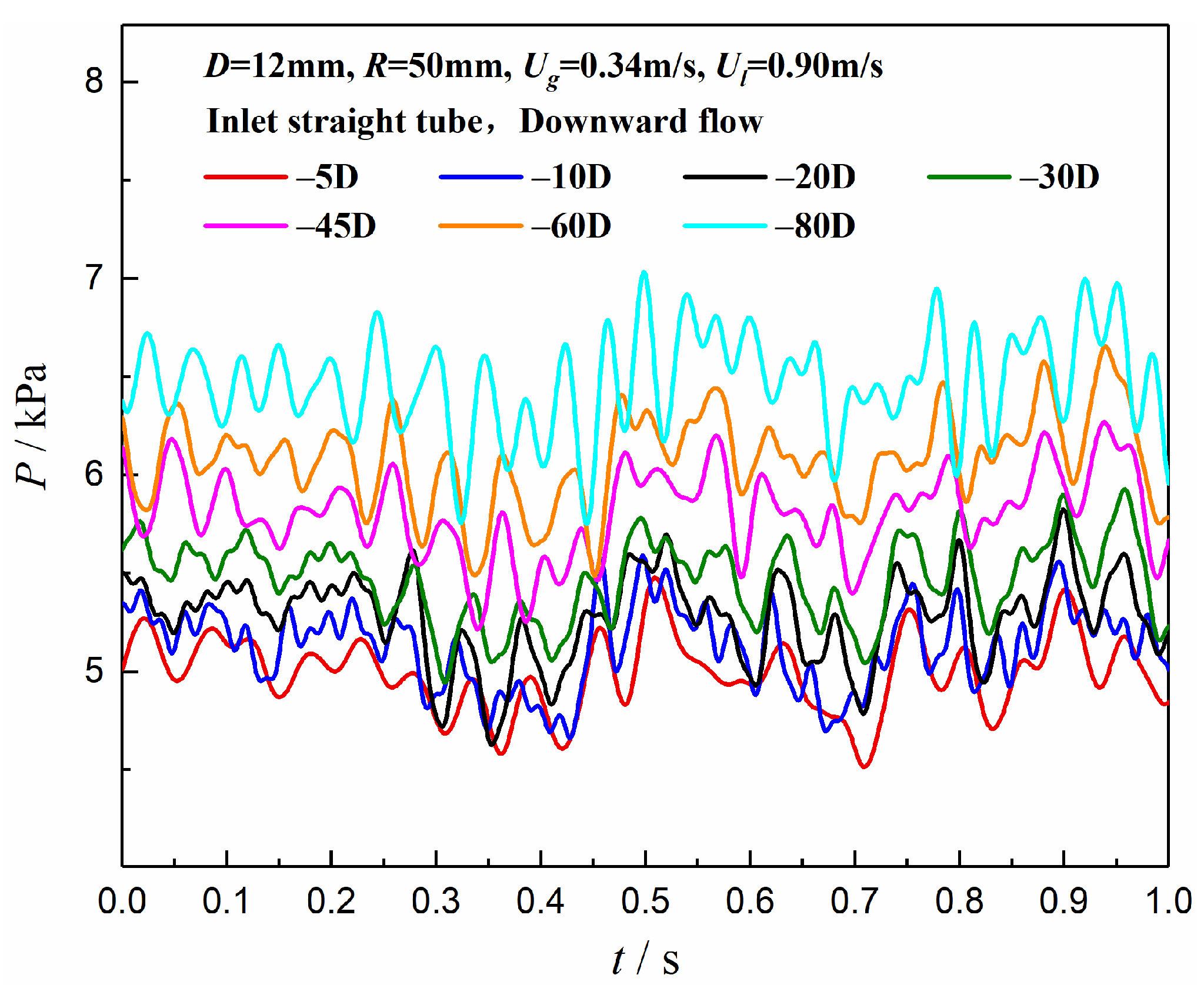

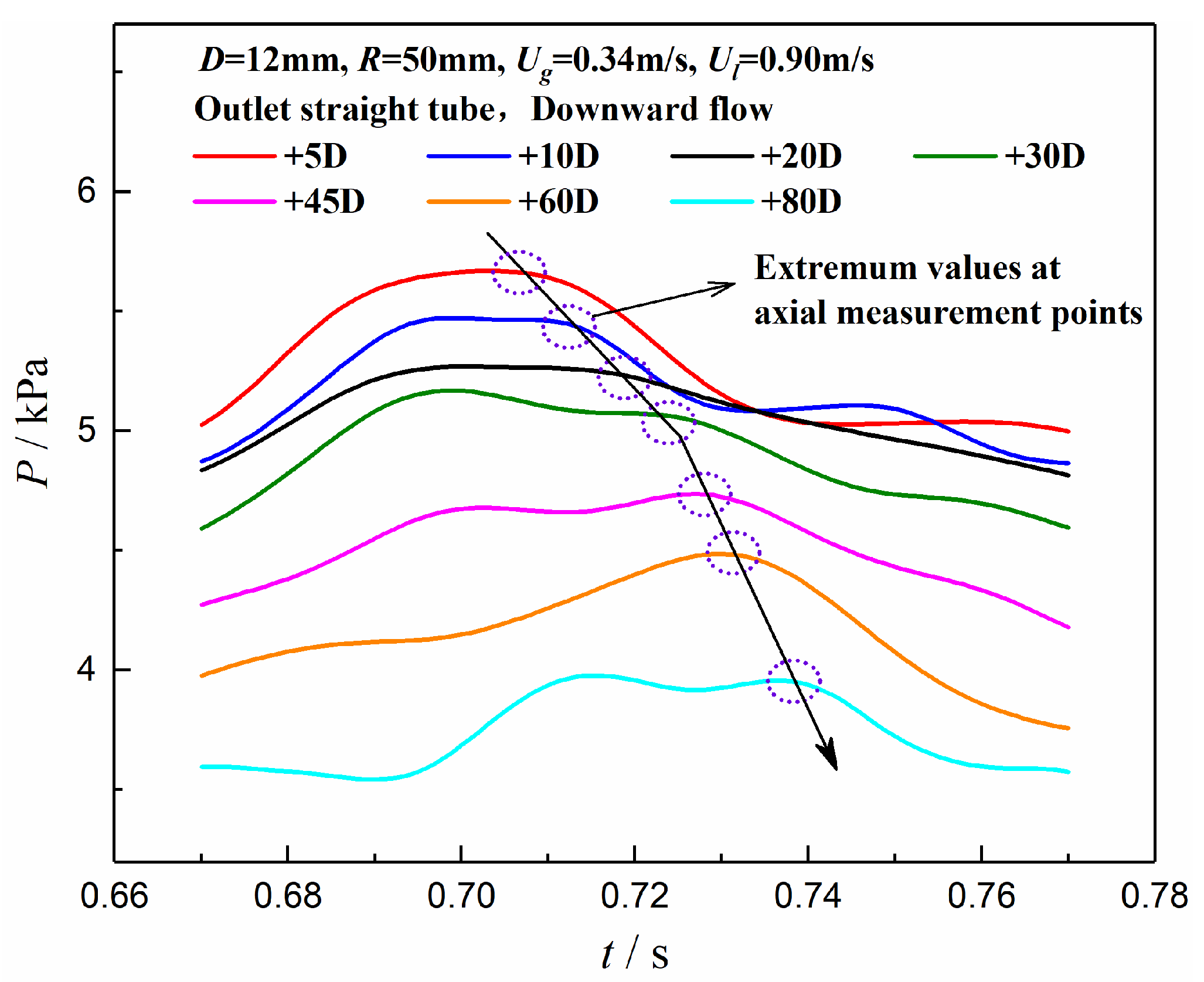
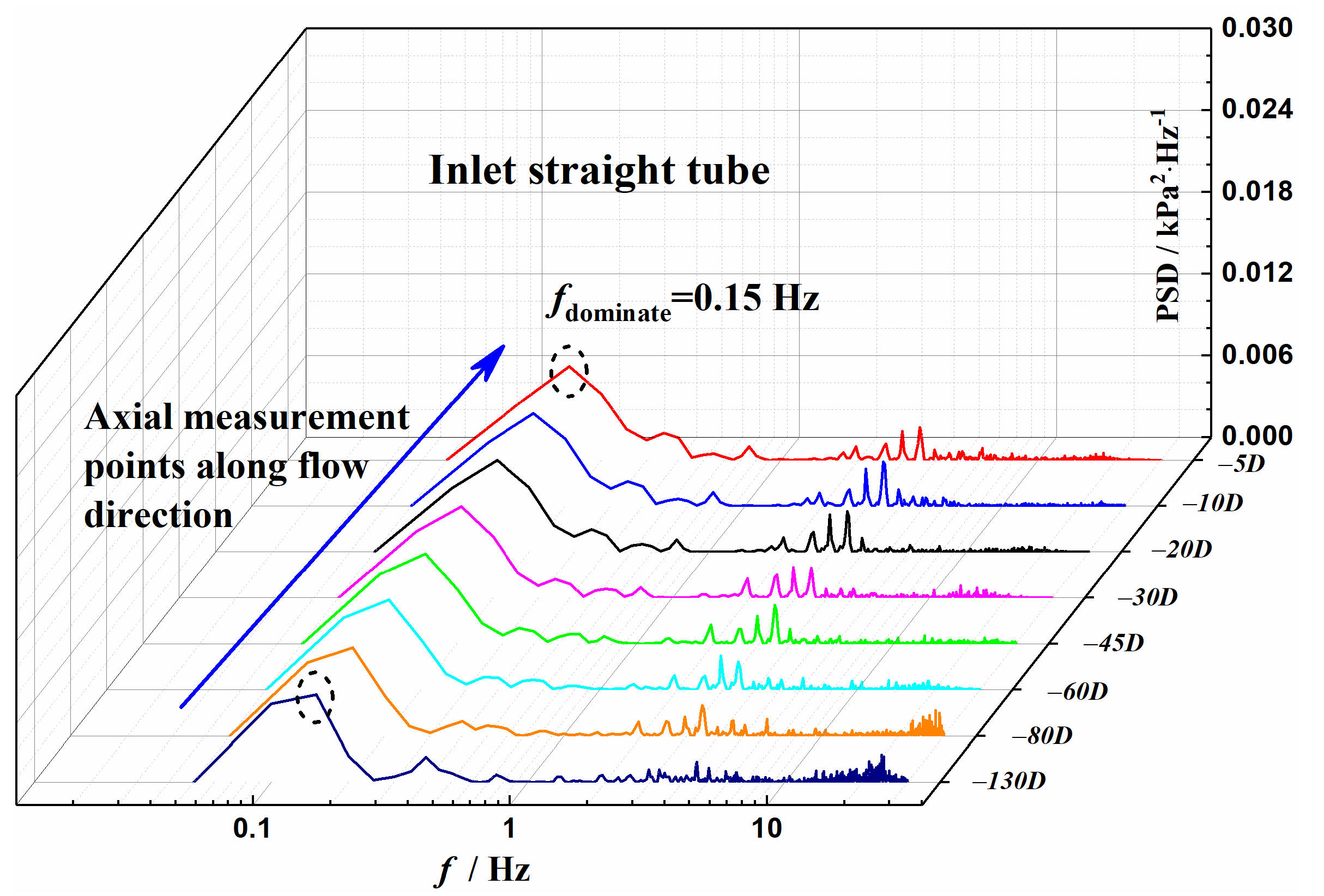
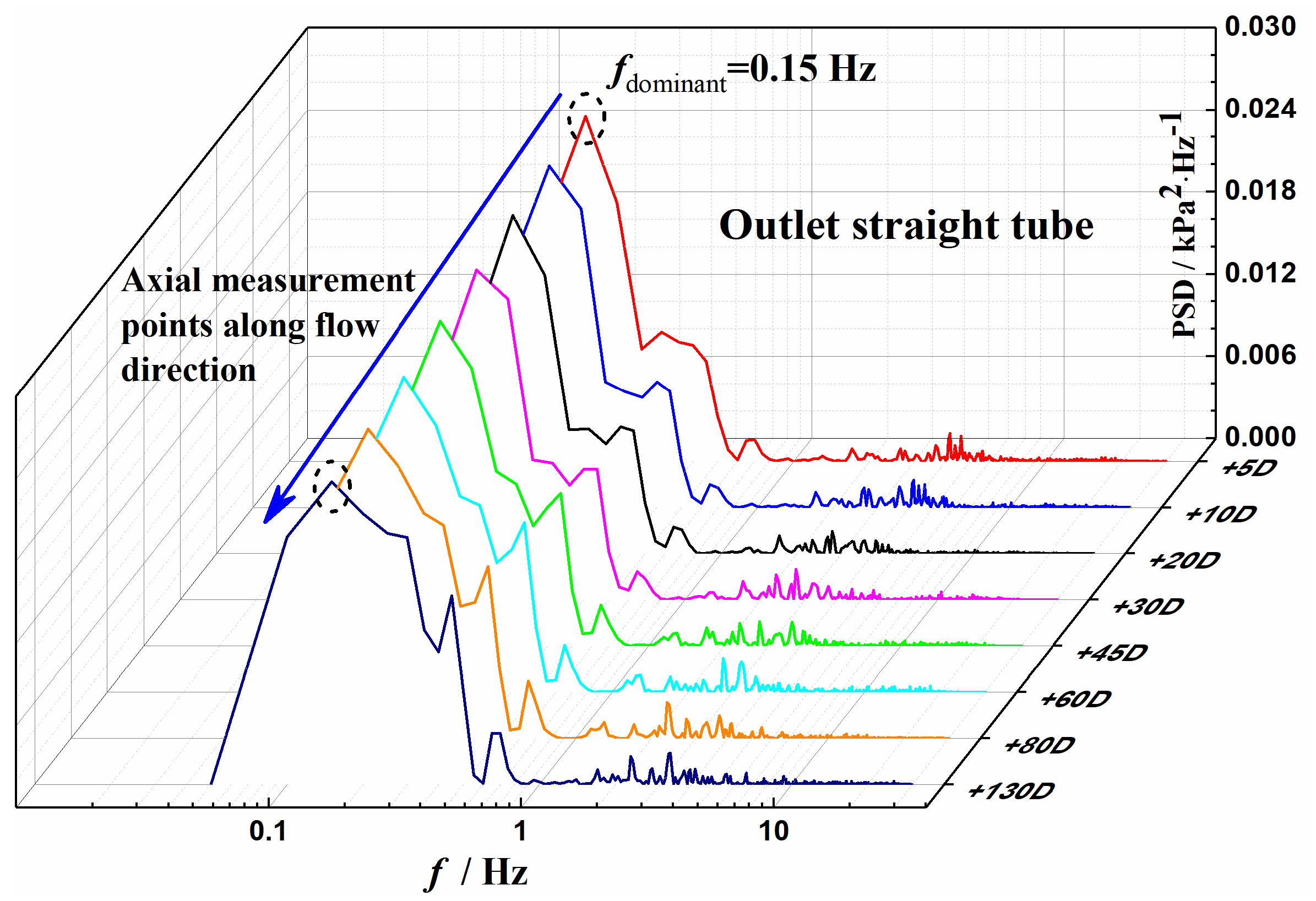

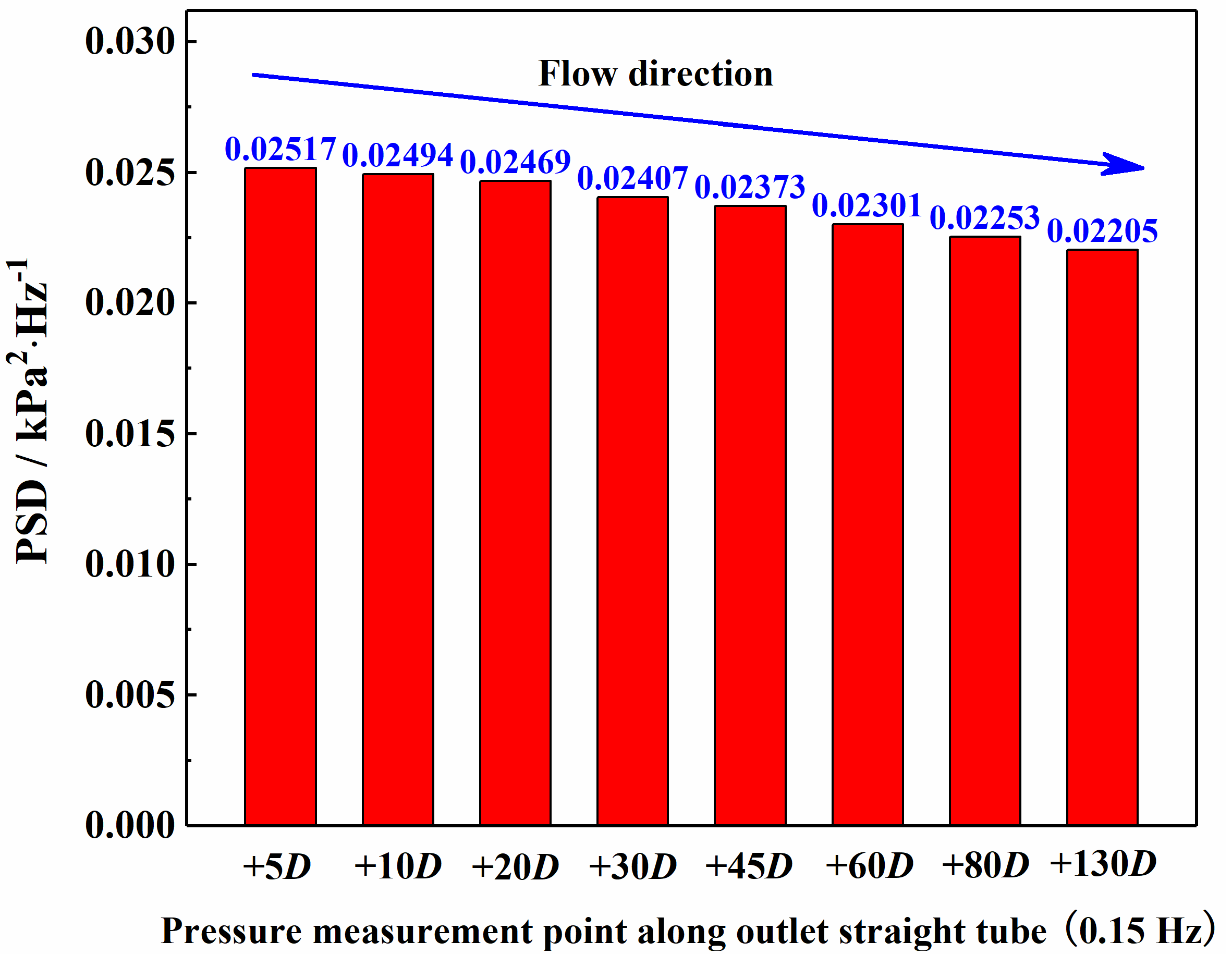
| Inlet Interval Segments | Location of Center/D | Outlet Interval Segments | Location of Center/D |
|---|---|---|---|
| P8P7 | −105 | P1′P2′ | +7.5 |
| P7P6 | −70 | P2′P3′ | +15 |
| P6P5 | −52.5 | P3′P4′ | +25 |
| P5P4 | −37.5 | P4′P5′ | +37.5 |
| P4P3 | −25 | P5′P6′ | +52.5 |
| P3P2 | −15 | P6′P7′ | +70 |
| P2P1 | −7.5 | P7′P8′ | +105 |
| Author | Correlation | |
|---|---|---|
| HFM-based correlations | McAdams et al. [44] | |
| Awad and Muzychka [45] | ||
| SFM-based correlations | Chisholm [46] | |
| Friedel [47] | ||
| Muller-Steinhagen and Heck [48] | ||
| Xu and Fang [49] | where Y is defined according to Chisholm [46], La is defined according to Zhang [50]. |
| Author | Inlet Tube Section (P7P8) | Outlet Tube Section (P7′P8′) | ||
|---|---|---|---|---|
| MAD | MRD | MAD | MRD | |
| McAdams [44] | +27.9 | −24.1 | +32.4 | −30.6 |
| Awad and Muzychka [45] | +28.0 | −15.5 | +29.0 | −23.1 |
| Chisholm [46] | +27.8 | −12.7 | +27.4 | −20.4 |
| Friedel [47] | +30.7 | +19.9 | +21.4 | +9.7 |
| Muller-Steinhagen and Heck [48] | +33.0 | −28.9 | +36.7 | −35.2 |
| Xu and Fang [49] | +27.9 | −10.3 | +27.3 | −18.2 |
Disclaimer/Publisher’s Note: The statements, opinions and data contained in all publications are solely those of the individual author(s) and contributor(s) and not of MDPI and/or the editor(s). MDPI and/or the editor(s) disclaim responsibility for any injury to people or property resulting from any ideas, methods, instructions or products referred to in the content. |
© 2024 by the authors. Licensee MDPI, Basel, Switzerland. This article is an open access article distributed under the terms and conditions of the Creative Commons Attribution (CC BY) license (https://creativecommons.org/licenses/by/4.0/).
Share and Cite
Ma, X.; Gu, Z.; Ni, D.; Li, C.; Zhang, W.; Zhang, F.; Tian, M. Experimental Study on Gas–Liquid Two-Phase Flow Upstream and Downstream of U-Bends. Processes 2024, 12, 277. https://doi.org/10.3390/pr12020277
Ma X, Gu Z, Ni D, Li C, Zhang W, Zhang F, Tian M. Experimental Study on Gas–Liquid Two-Phase Flow Upstream and Downstream of U-Bends. Processes. 2024; 12(2):277. https://doi.org/10.3390/pr12020277
Chicago/Turabian StyleMa, Xiaoxu, Zongyao Gu, Delong Ni, Chuang Li, Wei Zhang, Fengshan Zhang, and Maocheng Tian. 2024. "Experimental Study on Gas–Liquid Two-Phase Flow Upstream and Downstream of U-Bends" Processes 12, no. 2: 277. https://doi.org/10.3390/pr12020277




